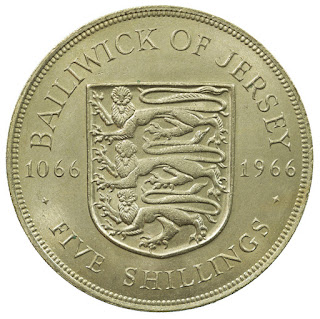Jersey Coins 5 Shillings 1966 Queen Elizabeth II - 900th anniversary of the Norman Conquest
Commemorative issue: 900th Anniversary of the Battle of Hastings
The obverse depicts Cecil Thomas' famous crowned portrait of the H.M. Queen Elizabeth II. This design also appears on the coins from Belize, Bermuda, British Eastern Caribbean Territories, British Honduras, British West Africa, Cyprus, East Africa, Fiji, Ghana, Hong Kong, Jamaica, Malaya and British Borneo, Mauritius, Nigeria, and Seychelles. The obverse has a simple legend of “QUEEN ELIZABETH THE SECOND.”
The reverse, designed by Georgie Edward Kruger Gray, features the Jersey Coat of Arms containing three lions and the dates ‘1066’ and ‘1966’ divided either side of the shield. The Jersey Coat of Arms derives from the seal granted to the island by King Edward Ι in 1279.
Lettering: BAILIWICK OF JERSEY 1066 1966 · FIVE SHILLINGS ·
Engraver: George Edward Kruger Gray
Denomination: 5 Shillings.
Metal: Copper-nickel.
Weight: 28.47 g.
Diameter: 38.61 mm.
Shape: Round.
Catalog Number: KM# 28.
Mintage:
1966 - 300,000.
1966 Proof - 30,000.
Norman conquest of England
The Norman conquest of England was the 11th-century invasion and occupation of England by an army of Norman, Breton, and French soldiers led by Duke William II of Normandy, later styled as William the Conqueror.
William's claim to the English throne derived from his familial relationship with the childless Anglo-Saxon King Edward the Confessor, who may have encouraged William's hopes for the throne. Edward died in January 1066 and was succeeded by his brother-in-law Harold Godwinson. The Norwegian king Harald Hardrada invaded northern England in September 1066 and was victorious at the Battle of Fulford, but Harold defeated and killed him at the Battle of Stamford Bridge on 25 September. Within days, William landed in southern England. Harold marched south to confront him, leaving a significant portion of his army in the north. Harold's army confronted William's invaders on 14 October at the Battle of Hastings; William's force defeated Harold, who was killed in the engagement.
Although William's main rivals were gone, he still faced rebellions over the following years and was not secure on his throne until after 1072. The lands of the resisting English elite were confiscated; some of the elite fled into exile. To control his new kingdom, William granted lands to his followers and built castles commanding military strongpoints throughout the land. Other effects of the conquest included the court and government, the introduction of the Norman language as the language of the elites, and changes in the composition of the upper classes, as William enfeoffed lands to be held directly from the king. More gradual changes affected the agricultural classes and village life: the main change appears to have been the formal elimination of slavery, which may or may not have been linked to the invasion. There was little alteration in the structure of government, as the new Norman administrators took over many of the forms of Anglo-Saxon government.
Battle of Hastings
The Battle of Hastings was fought on 14 October 1066 between the Norman-French army of William, the Duke of Normandy, and an English army under the Anglo-Saxon King Harold Godwinson, beginning the Norman conquest of England. It took place approximately 7 miles (11 kilometres) northwest of Hastings, close to the present-day town of Battle, East Sussex, and was a decisive Norman victory.
The background to the battle was the death of the childless King Edward the Confessor in January 1066, which set up a succession struggle between several claimants to his throne. Harold was crowned king shortly after Edward's death, but faced invasions by William, his own brother Tostig and the Norwegian King Harald Hardrada (Harold III of Norway). Hardrada and Tostig defeated a hastily gathered army of Englishmen at the Battle of Fulford on 20 September 1066, and were in turn defeated by Harold at the Battle of Stamford Bridge five days later. The deaths of Tostig and Hardrada at Stamford Bridge left William as Harold's only serious opponent. While Harold and his forces were recovering, William landed his invasion forces in the south of England at Pevensey on 28 September 1066 and established a beachhead for his conquest of the kingdom. Harold was forced to march south swiftly, gathering forces as he went.
The exact numbers present at the battle are unknown; modern estimates are around 10,000 for William and about 7,000 for Harold. The composition of the forces is clearer; the English army was composed almost entirely of infantry and had few archers, whereas only about half of the invading force was infantry, the rest split equally between cavalry and archers. Harold appears to have tried to surprise William, but scouts found his army and reported its arrival to William, who marched from Hastings to the battlefield to confront Harold. The battle lasted from about 9 am to dusk. Early efforts of the invaders to break the English battle lines had little effect; therefore, the Normans adopted the tactic of pretending to flee in panic and then turning on their pursuers. Harold's death, probably near the end of the battle, led to the retreat and defeat of most of his army. After further marching and some skirmishes, William was crowned as king on Christmas Day 1066.
There continued to be rebellions and resistance to William's rule, but Hastings effectively marked the culmination of William's conquest of England. Casualty figures are hard to come by, but some historians estimate that 2,000 invaders died along with about twice that number of Englishmen. William founded a monastery at the site of the battle, the high altar of the abbey church supposedly placed at the spot where Harold died.

